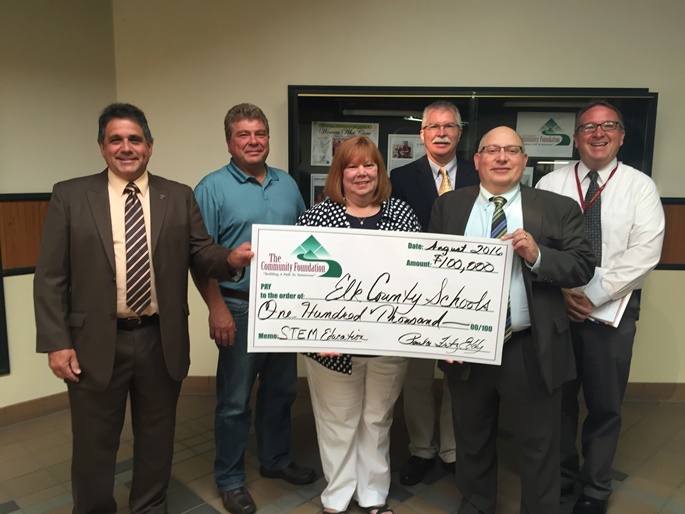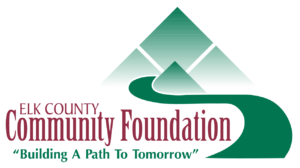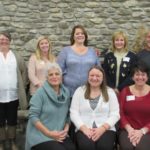STEM Education Fund Distributes $100,000!
Recently representatives from local county schools received $100,000 of grant funding for STEM education in their Middle School class rooms. The STEM Education Fund is a donor advised fund held and administered by the Elk County Community Foundation (ECCF). This initial grant of $25,000 for each school will provide them with moneys that will allow them to enhance or create a STEM lab in their middle schools. A group of donors represented at the meeting by Tom Jesberger as chairman of the advisor committee reviewed the applications and recommended the award to each district and the catholic school system. The committee was impressed by the dedications staff and teachers who took the time to evaluate their school’s needs and request the equipment and tools that would best impact their students.
The STEM fund, has been established by Mr. Arlan Clayton from Sarasota Florida. Clayton has been involved with the STEM program through the Gulf Coast Community Foundation in Florida, and had contacted the Elk County Community Foundation over a year ago to inquire about starting this STEM Education Fund in Elk County. He operated a successful manufacturing business in our community and “wanted to provide meaningful educational assistance in the communities where he had operated his businesses” In addition, Tom Jesberger, former owner of Abbot Furnace Company, took an interest in the project and has spear headed working with the schools, as wells as making a donation to the new Fund. This past spring the local schools were approached and given the opportunity to submit a grant application for the inaugural grant.
Currently, the Ridgway Area School District (RASD) is using a Science curriculum entitled Interactive Science. The curriculum does foster an interactive approach but lacks the needed integration of science into to other academic areas. The current offerings do not really infuse the engineering and math components at a high enough level to meet the needs of the true STEM piece. The ultimate goal for RASD is to help students apply education to real world problem solving, particularly in a team environment. Obviously a lab space would be more conducive to the success that goal. Plans are to equip a room with work station type tables and chairs, along with computers/mobile devices, smartboards and white boards. Unit curricular purchased for the program will be those that match the current topics in education. The ideal model would be one that allows the infrastructure hardware to be the backbone of the lab, while allowing for a variety of topics and units that students/groups could choose from in order to create intrinsic motivation. The design contains all necessary equipment, furniture, and necessities for a long term effective STEM environment.
Johnsonburg Area School District current curriculum for 7th and 8th grade science utilized the Houghton Mifflin Harcourt’s ScienceFusion series, which is designed for building inquiry and STEM skills. Their need has been a lab which would allow for more student collaboration and exploration. The focus of JASD project centers around providing such STEM lab which would foster these activities. The district realizes the jobs of tomorrow require not only knowledge, but the ability to work effectively in teams. These lab/work station would provide the environment to meet the needs of the student while helping them apply knowledge to solve complex problems. They plan to use their funding to create a STEM lab in the JR/SR High Building. The STEM lab will be scheduled to ensure that 7th and 8th grade classes will have access to it daily. Their classroom calls for the creation of five student workstations where teams of students can collaborate and utilize mobile handheld units, probes, and touchscreen all-in-one computers. The design is modeled after the STEMSmart classrooms of Sarasota Public Schools. These STEMSmart Tech Active classrooms are where our donor Arlan Clayton first experienced STEM programing and brought the funding to our community. Their plan is to transform the Jr. High science courses into the interactive collaborative models needed to train and excite the students for success in the STEM fields.
In 1998 St. Marys Area School District (SMASD) completed and expansive technology initiative that converted its wood shop to a technology lab with similar principles to STEM labs. This has been a separate curriculum that each student is 6th, 7th, and 8th grade takes daily for one quarter of the school year. It has been abundantly clear that students find the Technology Education courses motivating and engaging. The middle school technology lab is an excellent resource and is built as a separate course. It is also recognized that the they must pursue integration of STEM across subject areas versus a separate course/class. From the perspective of teacher and administrators, this is not an add or increase of topics to cover, it is a question of how we learn and teach in terms of strategies and transformative tools. The district is planning to integrate STEM tools in three middle school science labs for 20016-17 school year. Two rooms were originally constructed as science labs while the third is a regular classroom. They are redesigning these labs to support them with sustainable STEM tools. The lab locations would provide flexibility for use by other disciplines as well. The classroom configuration will include mobile lab tables, chairs and white boards along with computers, an audio system and hand held devices for students. SMASD administration has committed additional dollars to this upgrade and will provide the professional development and support to ensure the program’s success.
Elk County Catholic School System has had an ongoing commitment to STEM at the St. Marys Catholic Middle School(SMCMS) and Elk County Catholic High School(ECCHS). In the mid 2000’s a six station science lab was installed in the middle school and has since been moved and re-installed at their new location on Maurus St. In all middle school science courses an emphasis has been placed on hands-on instruction. The plans for this grant would be to focus on creating another lab style classroom and acquire some additional technology that will support the STEM programs. Within that includes additional devices, apps and equipment used with the educational program. This second lab will have a flexible furniture where the space can be configured for instruction or lab activities. The Technology they plan to use will enhance and compliment the types of programs already used within the school system, making it an easy transition for staff and student. Handheld hardware with new software and apps will support the educational standards in science, technology, engineer and math that is required and will foster problem solving, innovative thinking, communications, productive teamwork and decision making.
Pictured are left to right:Bob Rocco of RASD; Tom Jesberger STEM Education Fund; Paula Fritz Eddy, Executive Director of the ECCF; Dennis Crotzer, JASD; Dr. Brian Toth, SMASD and Sam MacDonald, ECCSS.



